Cathy Trost
- 1981

Fellowship Title:
- Evolution of Toxic Pollution Policy - Hooker Chemical Corporation
Fellowship Year:
- 1981
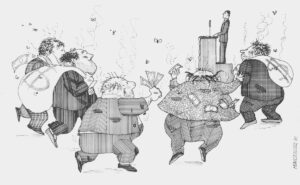
The Filthy Five
WASHINGTON, DC.–Bob Eckhardt, the softly drawling Texas Democrat whose bow ties and principled stands added a grace to the halls of Congress for 14 years, was beaten in the 1980 elections by a 28year-old Houston attorney who preached the Republican gospel of less government and lower taxes. Bob Eckhardt: “PACs create institutionalized, sanitized and ethical bribery.” WIDE WORLD PHOTO It was the shifting political wind that did Eckhardt in; that, and the three-quarters of a million dollars raised largely from corporate political action committees, which were more interested in defeating Eckhardt than electing his opponent, Jack Fields. One of the corporations that helped to defeat Eckhardt was Occidental Petroleum Corporation, the oil, chemical and mining conglomerate whose subsidiary, Hooker Chemical Company, is headquartered in Houston. The Fields-Eckhardt race was hardly more than a side bet for the strategists behind Occidental’s PAC. Fields was given $500 in an election year when the huge, computer-organized PAC dispensed nearly $120,000 to presidential, congressional, gubernatorial, judicial, and even Texas Railroad Commission candidates. Since early 1978, when Occidental filed its
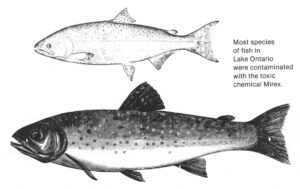
The Northern Fish Mystery
BURLINGTON, Ontario–Klaus Kaiser felt no sense of urgency as he drove east across Canada in the summer of 1973 toward an obscure fishing station called Glenora in Lake Ontario’s Bay of Quinte. The young, German-born research scientist for Canada’s equivalent of the Environmental Protection Agency was simply enjoying a brief holiday on the shores of this calm inland sea called “lake-fine” by its Iroquois settlers. Canadian research scientist, Klaus Kaiser: “I personally prefer not to eat any fish from Lake Ontario.” Kaiser had been doing some work in the area of PCBs, the ubiquitous chemical that was turning up in every corner of the world. His colleagues at Glenora had just caught some fish upstream and Kaiser asked for a few to take back to his lab to test for PCB contamination. He left for home accompanied by a Northern Pike and a Northern Longnose Gar. Kaiser had no idea of the chain of events he was setting into motion as he drove back to his office in Burlington. Hidden inside the two fish in
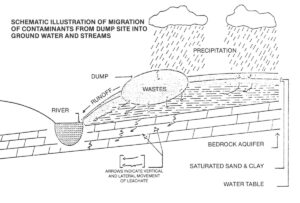
A Creek Called Bloody Run
LEWISTON, N.Y.–During the 1950s, a decade that would come to be remembered by many as an uncomplicated, golden time when the market was bull and what was good for General Motors was good for the country, Hooker Chemical Company paid $48,000 for a strip of swampy land about six miles north of the rushing waters of Niagara Falls and began filling it up with chemical waste. Like the rest of the country, Hooker was growing prosperous. It produced more wastes from its thriving industrial chemical business than it knew what to do with. The company acquired three smaller chemical firms in the space of two years and strengthened what would eventually become a 250-chemical production line at its big, belching Niagara Falls plant. Residues from that plant had already filled up a trench called the Love Canal on the eastern edge of the city. Looking around for a new dumpsite, Hooker found the marshy strip of land just below the Lewiston city line in the township of Niagara. Just a few miles to the north
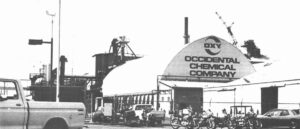
Good Neighbor Policy
LATHROP, Cal.–The day after her 27-year-old husband died, Marta Trout and her relatives conducted a wake of sorts in front of the living room television, where the president of Hooker Chemical Company was being interviewed on -60 Minutes.” Mrs. Trout was struck by something the Hooker executive said on that bleak Sunday evening, just a few days before Christmas, 1979. She can still repeat it word for word: “No one has been hurt at Lathrop. No one. No one has been hurt and no one will be.” “We all sat there and watched this guy say these things big as life. It was the biggest lie,” recalled Mrs. Trout, 26, from her ranch-style home in the San Joaquin Valley, which she has decorated with photographs of her husband and his collection of amateur baseball league trophies. Her tow-headed son sat on his mother’s lap, sucking his thumb. The boy was too small when his father died to remember him now as “anything but a picture. “ Michael Trout died December 15, 1979, from a hemorrhage
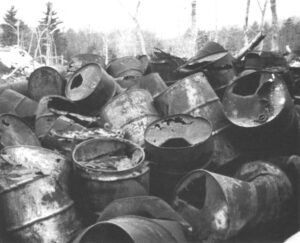
Cost-efficient Contamination
MONTAGUE, Mich.–The town of Montague, Michigan, sits up against the rolling bluffs of White Lake, hundreds of miles from the industrial centers of Detroit and Chicago. Every springtime, sap from the sugar maples runs like rainshowers and the lake is fat with perch and bass. In the springtime of 1951, however, there were also no jobs. “We were a community down at the heels,” recalls 79-year-old Wendell Lipka, who lives with his wife of 55 years in a house on the ravine over Little Buttermilk Creek. So it was, in 1951, that the town of Montague mortgaged its best asset-the clear wilderness lake-for the promise of 125 good-paying jobs and an $11 million tax base. In time, the lake became polluted, the groundwater was destroyed, the town split apart, and a chemical company had to dig a hole as wide as 13 football fields to accommodate the poisonous wastes those 125 jobs had created. The spirit of expansionism has been as much a part of Montague as any other American town during the past century
